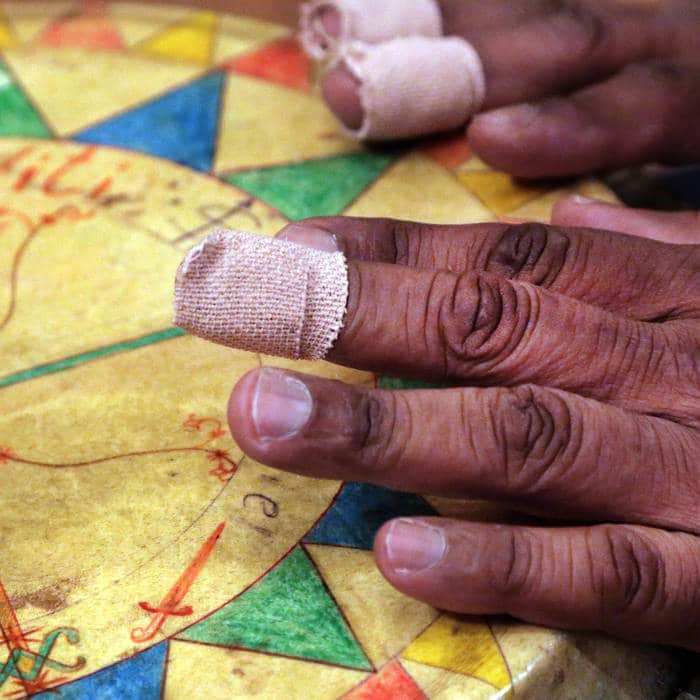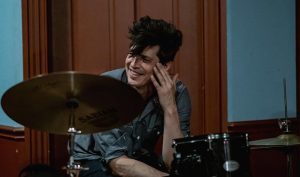Ches Smith and We All Break Meld Haitian Vodou and Jazz on ‘Path of Seven Colors’
During the Haitian Revolution, which straddled the turn of the 19th century, many French landowners on Quisqueya — the original Amerindian name of the island, renamed by the Spanish as Hispaniola — fled to escape bloodshed. Some of them brought their Afro-Haitian slaves to Eastern Cuba, where that culture became expressed as Tumba Francesa. In my ancestral homeland, Puerto Rico, it manifested itself as Bomba. And in New Orleans, Afro-Haitian rhythms, alongside those of Cuba and Puerto Rico, became the rhythmic DNA of second-line marches, ragtime, the blues, and vodou culture. It provided a rhythmic jump start to the music we know as jazz.
That collective history and its influences are barely touched, if mentioned at all, in most jazz histories. But that may begin to change with the arrival of Path of Seven Colors, an album by Ches Smith and We All Break, arriving this Friday on Pyroclastic Records.
Smith, best known as a drummer on the experimental music scene, first encountered the musical tradition of Haitian vodou more than 20 years ago. “I was captivated,” he writes in the album liner notes, “because things central in the various musics I play — polyrhythm, polytonality, improvisation, extended timbral awareness, tension and release, channeled aggression and power, and most vitally surprise — I found again, and anew, in this traditional form.”
To fulfill his vision, Smith assembled a stellar ensemble with Miguel Zenón on alto saxophone, Matt Mitchell on piano and Nick Dunston on bass. They work seamlessly with the album’s folkloric elements — the work of master drummers Daniel Brevil, Markus Schwartz and Fanfan Jean Guy Rene, along with vocalist Sirene Dantor Rene. Their knowledge of the spiritual side of vodou melds seamlessly with Smith’s forward-thinking compositions.
WBGO is proud to premiere We All Break, an hourlong documentary film by Mimi Chakarova, which goes behind the scenes of Path of Seven Colors.
Minimalist in nature, Chakarova’s film focuses on the action in the studio, interspersed with choice insights from the musicians. To accentuate the spiritual nature of the project, beautiful images filmed in Haiti meet with a moment of silence at 39:40, lingering on the image of a young child. Impressionistic views of nature, and a few more faces in profile, follow in more silence — ending on the haunting image of a lone woman, clad in black and red. These are the colors of Legba, as he is known in Haitian vodou, and Eleguá in Cuban Santería: guardian of the crossroads.
Nothing is born in a vacuum. New York City has had an established Haitian community, centered mostly in Brooklyn, for many years. The sounds of the rocksteady Haitian Compas (Konpa) can be heard resonating from dance halls all over the borough. There were also earlier attempts at fusing jazz with authentic Afro-Haitian rhythm — by pianist Ernst Marcelin and his group Freefall, Mozayik, as well as master drummer Frisner Augustin and La Troupe Makandal.
In Miami, the avant-garde guitarist Monvelyno Alexis and trumpeter Jean Caze have also been fusing jazz and Haitian rhythms. And young musicians like Sarah Elizabeth Charles and Godwin Louis have been exploring the same idea in New York.
We All Break more closely parallels the hybrid of the Machito Afro-Cubans, whose integration of the improvisational and harmonic concepts of jazz fused with Afro-Cuban rhythms in New York City in the ‘40s. It eventually led to the incorporation of deeply rooted Afro-Cuban religious-based drumming, melodies and chants — as exemplified by Tito Puente, Mongo Santamaria, Mark Weinstein, Jerry Gonzalez and the Fort Apache Band in New York, and Irakere in Cuba.
The spirit of melding on Path of Seven Colors is well expressed by Smith and others in the film. “The thing that was really enlightening for me was to see how a lot of the things that I knew – even things from Puerto Rico – had their roots in Haitian music,” Zenón observes.
Later, he articulates a common purpose: “A lot of times you read the paper and you realize… you’re not really getting the full scope of what’s happening in the world, they’re just telling you what they want to tell you. So we were just talking about what’s happening in Haiti, the Dominican Republic, Puerto Rico. All these places are in turmoil, and dealing with many different things. So it’s nice to feel that we have a lot of stuff in common and we’re all kind of fighting for the same things.”


